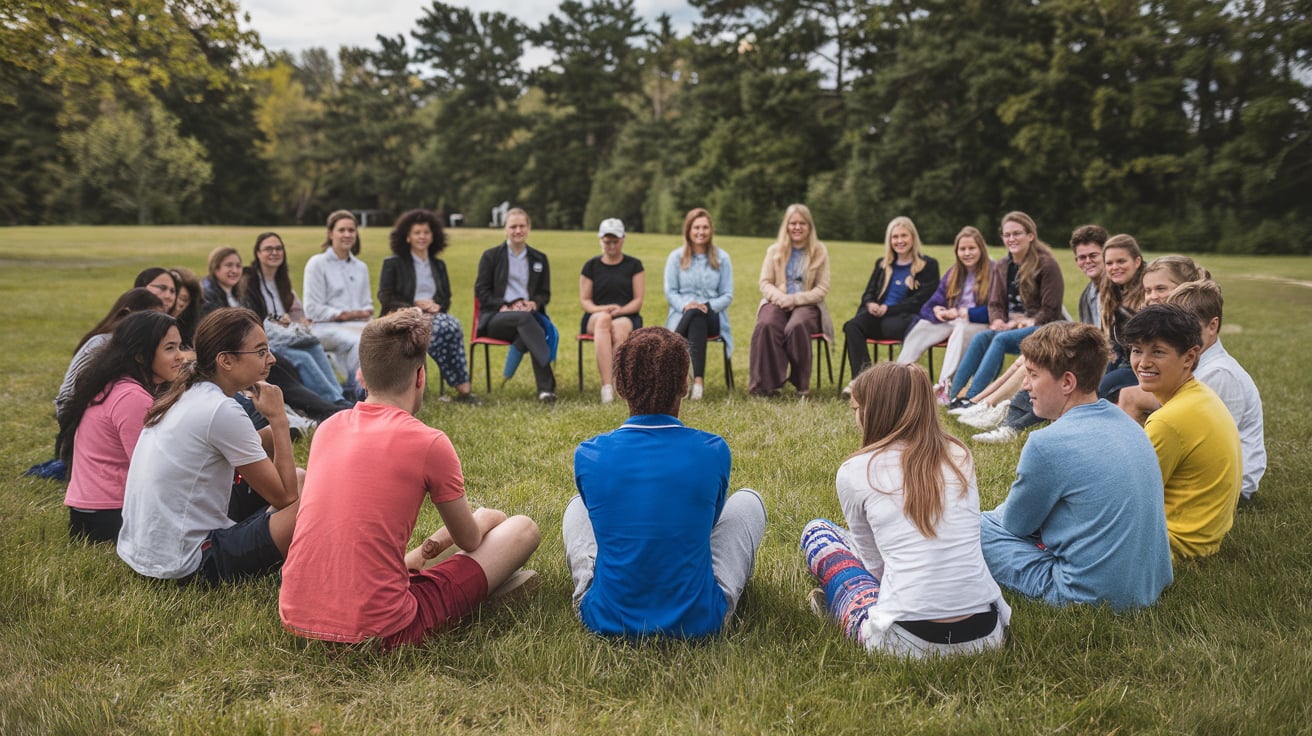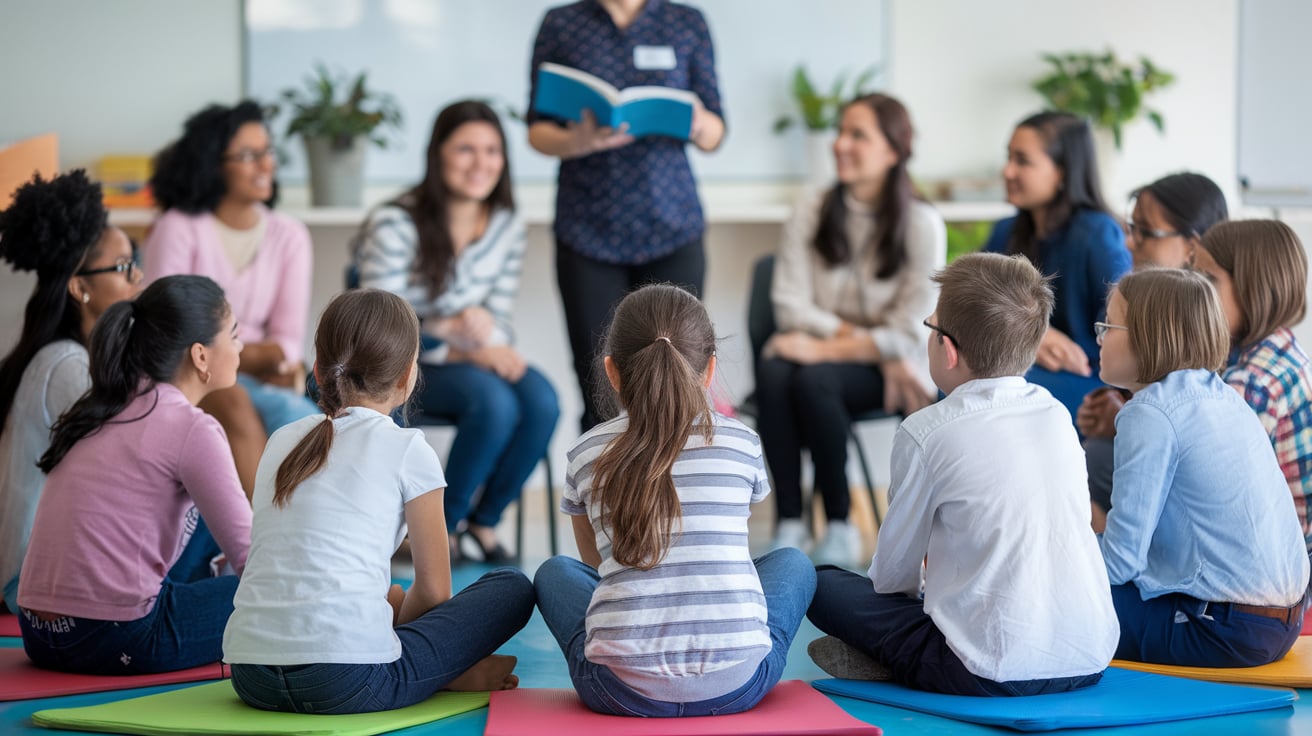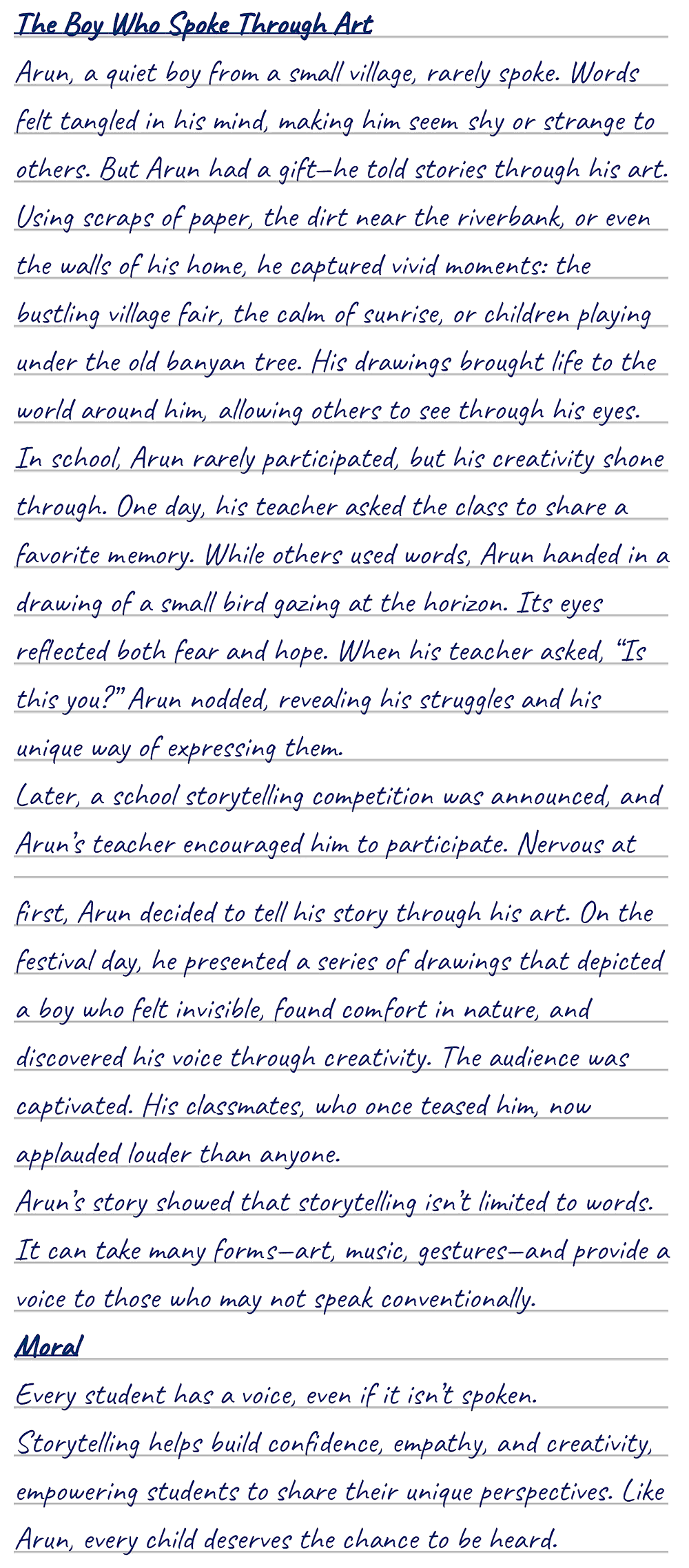
Storytelling is not just about entertaining people; it is a fundamental communication skill that helps us connect, convey ideas, and build understanding. Storytelling is an invaluable tool that enhances students' creativity, communication, and empathy. Whether you're a parent, teacher, or student, understanding the importance of storytelling can inspire you to harness its potential for personal and academic growth.
This article explores the significance of storytelling in education, its benefits, practical applications, and transformative impact on students.
Table of Content
What is Storytelling, and Why is It Essential?
Storytelling is a timeless art involving narratives that communicate emotions, ideas, and information. As old as humanity, this practice has historically been used to teach moral lessons, preserve cultural history, and foster connections between individuals and communities. It has always been integral to how humans process and share knowledge, ensuring that traditions and values are passed on to future generations.
In modern education, storytelling transcends its traditional boundaries. It is no longer confined to the pages of literature or the oral traditions of the past; it has become a versatile and dynamic teaching tool. Educators use storytelling to make learning more engaging, simplify complex topics, and encourage meaningful conversations. It allows students to explore new ideas, challenge assumptions, and better understand their study subjects.
The effectiveness of storytelling lies in its key elements. A good story is structured with a clear beginning, middle, and end, providing a logical flow that makes the narrative easy to follow and understand. Characters are central to stories, allowing listeners or readers to form emotional connections making the content more relatable. The emotional resonance of stories is another crucial aspect; when students feel connected to a story, they are more likely to remember its content. Additionally, vivid imagery created through descriptive details helps to paint mental pictures, making abstract ideas tangible and memorable.
Through storytelling, students gain essential skills that extend beyond the classroom. They learn to organize their thoughts coherently, articulate their ideas clearly, and connect emotionally and intellectually with others. Storytelling equips students for academic success, lifelong communication, and personal growth.
How Storytelling Benefits Students

Storytelling has profound benefits for students, extending far beyond the simple act of recounting a narrative. It is a multifaceted tool that shapes their communication, creativity, critical thinking, empathy, and memory retention, preparing them for personal, academic, and professional growth. Let's explore these benefits in detail.
1. Improves Communication Skills
Sharing a story demands clarity of thought and expression. When students narrate a story, they are compelled to select their words carefully, structure their ideas coherently, and deliver their message in a way that resonates with the audience. This process enhances their ability to communicate verbally and in writing effectively.
Storytelling also hones the skill of adapting tone and delivery to suit different contexts and listeners, essential in academic presentations, group discussions, and even casual conversations. For example, a student recounting a personal experience in front of their peers might use humor and relatable details. At the same time, the same story presented in a formal setting may require a more structured and polished approach.
Research conducted by the National Storytelling Network has demonstrated that storytelling significantly improves public speaking and interpersonal communication. These foundational skills boost students' confidence and prepare them for success in their future careers, where clear and impactful communication is often a decisive factor.
2. Boosts Creativity and Imagination
Storytelling encourages students to tap into their creative instincts. Crafting a story—fictional or based on real-life events—requires them to think outside the box, visualize scenarios, and bring their ideas to life. This creative engagement develops their ability to approach problems and ideas from multiple angles.
For instance, when asked to create a fictional story about climate change, a student might envision a world where trees communicate with humans to warn them of environmental dangers. This exercise sparks creativity and embeds critical thinking about real-world issues engagingly.
Creativity fostered through storytelling extends beyond academic settings. Employers across industries value innovation and the ability to think creatively. By practicing storytelling, students cultivate a mindset that prepares them to contribute original ideas and solutions in their future workplaces.
3. Enhances Critical Thinking and Problem-Solving
Storytelling is inherently analytical. When students engage with stories, they analyze characters, understand motivations, and consider the consequences of actions. This analytical process builds critical thinking skills that are crucial for problem-solving.
For example, while studying a novel, students might be asked why a character made a particular decision and how different choices could have led to alternative outcomes. Similarly, when crafting their own stories, students must resolve conflicts within the narrative, such as deciding how a protagonist overcomes obstacles. These exercises train their minds to approach problems methodically and consider diverse solutions.
Critical thinking developed through storytelling is easily transferable to real-world situations. Whether solving complex math problems, addressing ethical dilemmas, or navigating interpersonal challenges, students equipped with these skills are better prepared to make informed decisions.
4. Builds Empathy and Social Connections
Stories have the unique power to foster empathy by allowing listeners and storytellers to experience life from different perspectives. When students hear stories about characters or people from diverse backgrounds, they develop a deeper understanding of experiences different from their own. Similarly, sharing their own stories helps them connect with others by revealing their thoughts and emotions.
A Harvard Graduate School of Education study supports this social-emotional benefit. The study found that storytelling enhances social-emotional learning (SEL). Storytelling activities nurture skills like empathy, active listening, and collaboration, making classrooms more inclusive and harmonious.
For example, students might share stories about their cultural traditions in a classroom exercise. This builds empathy and strengthens peer relationships, fostering community and mutual respect.
5. Aids Memory Retention
Stories are more than entertaining—they are memorable. Research by educational psychologist Jerome Bruner revealed that information presented as a narrative is 22 times more likely to be remembered than facts presented in isolation. This is because stories engage multiple areas of the brain, linking emotions, images, and ideas in a way that facts alone cannot.
Storytelling can be a powerful tool for students. Instead of memorizing historical dates and events, students can learn about history through stories of individuals who lived during those times. For instance, a lesson on the Industrial Revolution might become more engaging and memorable when framed as the story of a young factory worker navigating the era's challenges.
Similarly, in science, the story of Marie Curie's perseverance in her groundbreaking research adds a human element to otherwise technical content, making it more relatable and more straightforward to recall.
The Research Supporting Storytelling in Education

Storytelling is a creative exercise and a robust educational tool backed by extensive research. Its benefits are observed across various dimensions of student development, including language acquisition, cognitive growth, and social engagement. When storytelling is integrated into the learning process, its impact is profound, helping students achieve better academic outcomes, enhance critical thinking skills, and prepare for real-world challenges. Here's a closer look at the research supporting storytelling in education.
1. Language Development
Storytelling is a natural method for developing language skills. A study published in the Journal of Child Language highlighted how storytelling improves young learners' vocabulary acquisition and reading comprehension. By engaging with stories, students are exposed to new words and contexts that enhance their linguistic abilities.
Storytelling provides an engaging and less intimidating way for students to practice a second language. Instead of memorizing vocabulary lists or grammar rules, they immerse themselves in narratives where language flows naturally. For instance, bilingual classrooms often use folktales to introduce students to cultural idioms and sentence structures. This approach makes language learning intuitive, helping students absorb complex linguistic patterns more effectively.
Additionally, storytelling activities such as group storytelling or collaborative story creation promote active listening. Students are encouraged to pay attention to narrative details, fostering receptive and expressive language skills.
2. Engagement and Motivation
Storytelling has been proven to increase student engagement, directly linked to better academic performance. A report by the National Literacy Trust revealed that students show higher motivation levels when lessons incorporate storytelling. This increase in engagement helps reduce dropout rates, particularly in at-risk populations.
Engagement through storytelling occurs because stories are inherently captivating. Unlike traditional teaching methods that rely heavily on lectures or rote learning, storytelling introduces an emotional component to the material. For example, a history teacher might recount a soldier's personal experiences during a historical war, making the subject more relatable and memorable.
Furthermore, engagement extends beyond the classroom. Motivated by storytelling activities, students are more likely to pursue independent research or creative writing projects, reinforcing the skills they learn in school.
3. Cognitive Benefits
The cognitive processes activated during storytelling are extensive. Storytelling requires students to organize events chronologically, reason through cause-and-effect relationships, and interpret emotions. These mental activities enhance overall brain development and cognitive flexibility.
Neuroscientific research supports this claim. Studies have shown that storytelling simultaneously stimulates multiple brain areas, including regions responsible for language processing, sensory perception, and emotional engagement. When students listen to or create stories, their brains work holistically, integrating various cognitive functions.
Additionally, storytelling strengthens memory retention. Educational psychologist Jerome Bruner discovered that narrative information is 22 times more likely to be remembered than data presented as isolated facts. For instance, a science teacher explaining photosynthesis might frame it as the story of a leaf's journey from sunlight absorption to oxygen production. This narrative structure helps students retain and recall the information more effectively.
4. Real-world Applications
Storytelling skills are not just academic; they are highly valued in the professional world. According to a LinkedIn report, 92% of hiring managers believe strong communication skills, including storytelling, are essential for workplace success. Whether delivering presentations, pitching ideas, or collaborating with colleagues, the ability to tell a compelling story enhances effectiveness.
Employers often emphasize storytelling as a tool for persuasion and relationship-building. For example, in marketing, professionals use narratives to connect with consumers emotionally. Similarly, in leadership roles, storytelling helps convey vision and inspire teams. By learning storytelling in school, students are better equipped to navigate these real-world scenarios confidently.
How to Teach Storytelling to Students
To harness the benefits of storytelling, educators must implement creative and inclusive strategies. Here are some practical methods:
1. Encourage Creative Writing
Creative writing is a foundational activity for teaching storytelling. Students can begin with simple prompts such as:
-
"Describe a moment that made you laugh."
-
"Imagine a day in the life of a time traveler."
These exercises help students structure their ideas and develop a narrative voice. Creative writing also fosters originality as students learn to express their thoughts uniquely.
2. Integrate Storytelling Across Subjects
Storytelling is not confined to English or literature classes. In history, students can recount significant events through the perspectives of historical figures. In science, experiments can be narrated as problem-solving adventures. For instance, a math teacher might use a story about a detective solving a mystery using algebraic equations, making abstract concepts more accessible and engaging.
3. Use Digital Tools
Technology has revolutionized storytelling. Platforms like Adobe Spark, Canva, or Storybird enable students to create visual stories using images, videos, and audio. Digital storytelling particularly appeals to today's tech-savvy learners, combining traditional narrative techniques with modern multimedia elements.
For example, a student working on a geography project might create a video story about a river's journey from its source to the ocean. These tools make storytelling interactive and immersive, encouraging creativity and innovation.
4. Practice Oral Storytelling
Oral storytelling is an excellent way to build confidence and improve public speaking skills. Teachers can host storytelling sessions where students share personal anecdotes or fictional tales with their classmates. These sessions strengthen verbal communication and promote active listening and peer-to-peer interaction.
5. Incorporate Role-Playing
Role-playing activities encourage students to imagine themselves as characters and narrate events from that perspective. For example, in a lesson about the Civil Rights Movement, students might assume the roles of historical activists and describe their experiences and challenges. Role-playing deepens empathy and fosters a nuanced understanding of different viewpoints.
Challenges in Teaching Storytelling
While storytelling offers numerous benefits, there are challenges to its implementation:
1. Limited Resources
Many schools need more tools or trained educators to incorporate storytelling effectively. Solutions include leveraging free online resources, partnering with local storytelling groups, and conducting teacher training workshops to build capacity.
2. Diverse Learning Styles
Not all students excel in verbal or written storytelling. To ensure inclusivity, educators can adapt activities to cater to different strengths. For instance, artistic students might create storyboards, while those with auditory learning preferences might focus on oral narratives.
3. Cultural Sensitivity
Stories often reflect cultural norms and values. Educators must ensure that storytelling activities celebrate diversity and create a safe space for students to share their unique backgrounds. Encouraging students to share folktales or personal stories from their heritage can enrich the classroom experience.
Real-Life Examples of Storytelling in Education
The transformative power of storytelling can be seen in real-world classrooms:
The "History as Stories" Method
At a middle school in California, history lessons are reimagined through storytelling. Students narrated events such as signing the Declaration of Independence as though they were witnesses. Engagement levels rose, and students demonstrated a deeper understanding of historical concepts.
Storytelling for Teamwork
In Finland, a teacher introduced storytelling to group projects. Teams created fictional businesses and narrated their journeys, from startup struggles to eventual success. This activity improved teamwork and engagingly taught entrepreneurial principles.
Digital Storytelling for STEM
At a New York school, students created stories explaining scientific principles using animation software. One group illustrated the process of photosynthesis through a narrative about a leaf's adventures, making the lesson memorable and enjoyable for their peers.

Why Every Student Needs Storytelling Skills
Storytelling is far more than an optional talent—it is an essential skill that plays a pivotal role in shaping how students perceive and interact with the world. It influences their ability to think critically, communicate effectively, and form meaningful connections. Regardless of their career paths—whether as teachers, engineers, entrepreneurs, or artists—the ability to construct and share a compelling story provides a decisive advantage.
At its core, storytelling equips students with tools for organizing thoughts and conveying ideas clearly and effectively. When students tell a story, they practice structuring information logically, selecting the right words to resonate with their audience, and delivering their message confidently. These academic abilities and life skills carry over into interviews, presentations, and day-to-day interactions.
Storytelling also fosters emotional intelligence. Students learn to empathize with different perspectives, understand complex emotions, and connect with others more deeply by engaging in narratives—creating their own or interpreting others. These skills are critical in today's interconnected world, where collaboration and understanding are paramount.
Moreover, storytelling cultivates creativity and problem-solving abilities. Constructing a narrative constantly involves imagining scenarios, addressing challenges within the plot, and finding resolutions—all of which mirror real-life problem-solving processes. For instance, an engineering student might use storytelling to present a design concept, explaining its purpose and impact through a relatable narrative that captures the audience's attention.
Research supports the value of storytelling across educational contexts. A study by the National Literacy Trust found that students who engage in storytelling activities demonstrate improved confidence, enhanced communication skills, and a greater willingness to participate in collaborative tasks. Neuroscientists have further shown that storytelling activates multiple brain areas, leading to better memory retention and cognitive engagement.
We invest in storytelling education in a generation of empathetic, articulate, and innovative individuals. Every student's voice matters, and storytelling gives them the platform to be heard. Whether recounting a personal experience, pitching an idea, or presenting a scientific concept, storytelling ensures the message is understood and remembered. Encouraging students to develop this skill is an investment in a brighter, more connected future where ideas, emotions, and knowledge flow seamlessly between people.
Takeaway
Storytelling transforms the way students learn, think, and grow. By teaching them to craft and share narratives, we equip them with skills beyond the classroom, preparing them for personal and professional success. Let's make storytelling a cornerstone of education and give every student the tools to tell their story to the world.
Students Learning Skills




